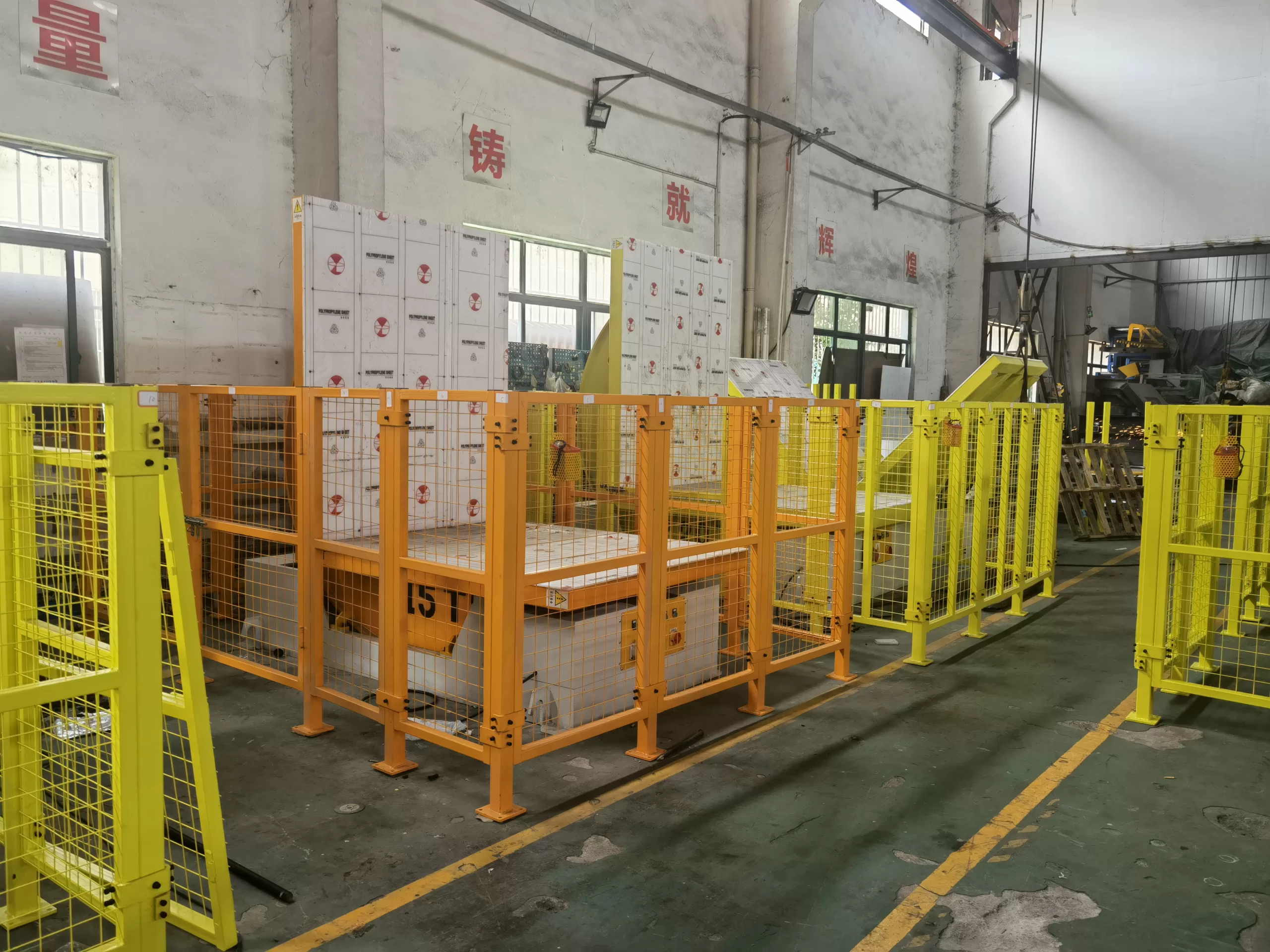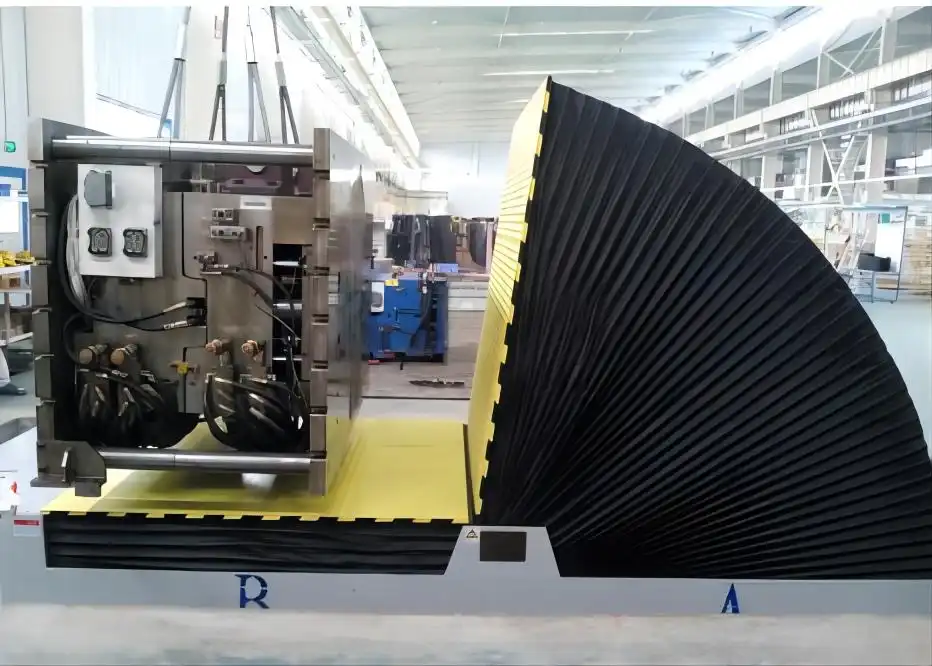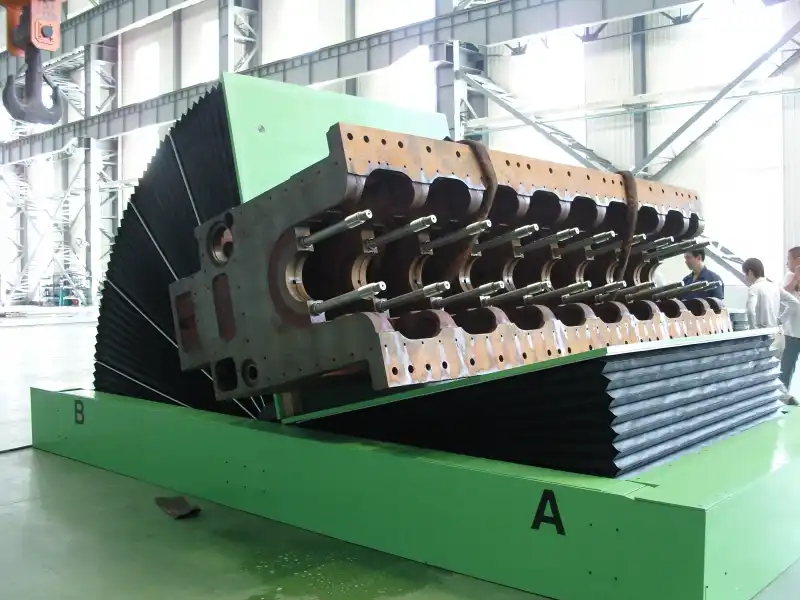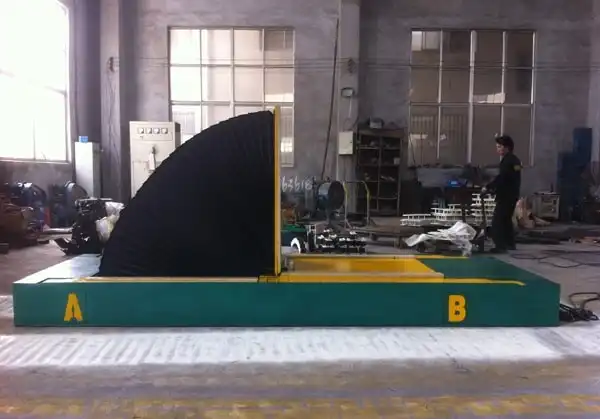Is Your Mold Flipping Process Slowing Down High-Volume Production in the U.S.?
High-volume manufacturing in the U.S. is a tough game. You are constantly fighting against the clock, trying to squeeze every bit of efficiency out of your production line. You have likely optimized your core processes, but there might be a hidden bottleneck that is quietly costing you time and money. I am talking about your mold flipping process. For many plants, it is a slow, manual task that everyone just accepts as "part of the job." But this acceptance comes at a high price. These delays accumulate, shift by shift, day by day, causing you to miss production targets. Worse, manual methods using cranes and chains create serious safety hazards and risk damaging your very expensive molds. This is not just a minor inconvenience; it is a direct threat to your productivity and profitability. But what if you could change this? What if that bottleneck could become a smooth, automated, and fast part of your workflow? Based on my years of designing and building this kind of equipment, I can tell you it is possible. A modern mold flipping solution can completely transform your process, cutting cycle times, boosting safety, and protecting your valuable assets.
Yes, a slow or outdated mold flipping process is a major bottleneck in many high-volume U.S. production facilities. Traditional methods that rely on overhead cranes, chains, and manual labor are inherently inefficient and unsafe. These processes introduce significant delays, create opportunities for human error, risk damage to expensive molds, and ultimately limit the overall throughput and profitability of the entire production line.

I have seen this situation in dozens of factories throughout my career. The issue is often bigger than just the time it takes to flip a mold. It is about the hidden costs, the constant safety worries, and the missed opportunities for creating a truly streamlined operation. An inefficient process in one area can have ripple effects across the entire plant floor. So, let's break down the specific challenges you might be facing and explore how a better solution can make a real difference. We will look at safety, technology, and the real return on investment you can expect.
You probably see it every day. A team of operators gathers around a large mold. They attach heavy chains, and an overhead crane slowly lifts and turns the massive piece of steel. Everyone holds their breath for a moment until it's safely on the other side. This process seems routine, but it is filled with risk. You worry about a chain slipping, a load swinging unexpectedly, or an operator’s hand getting caught in the wrong place. These are not just worries; they are legitimate safety hazards that U.S. factories must take seriously. But the danger is only part of the story. Think about the hidden costs. The process is slow, tying up not just the operators but also the crane, which might be needed elsewhere. And every time a chain presses into the surface of a mold, you risk causing small dents or scratches that can affect the quality of your final product. These issues add up, creating a constant, low-level drain on your resources and efficiency. A dedicated, automated mold flipper removes these variables. It secures the mold in a controlled environment and performs the flip smoothly and predictably, eliminating the immediate safety risks and the slow financial bleed from hidden operational costs.
Manual mold flipping methods expose U.S. factories to severe safety risks by creating situations where workers are in close proximity to heavy, suspended loads. The hidden costs are substantial, including the high labor cost of requiring multiple skilled operators and a certified crane operator for a single task, extended cycle times that create production bottlenecks, the cumulative cost of repairing molds damaged by chains and improper handling, and potentially higher insurance premiums due to the inherent risks involved.

The High Price of "Good Enough"
Early in my career, I was visiting a large stamping plant. They used the crane-and-chain method, and they were very good at it. Their team was experienced, and they had procedures for everything. But one afternoon, a new operator was a bit too eager. He misjudged the center of gravity when rigging the chains. As the crane lifted, the multi-ton mold shifted violently. It did not fall, but it swung hard, missing another worker by inches. The entire production floor stopped. That near-miss cost them an hour of downtime and a lengthy safety investigation. This is the reality of relying on manual methods. No matter how skilled your team is, you are always one moment of human error away from a disaster.
In the U.S., OSHA regulations are strict for a reason. Accidents involving suspended loads can be catastrophic. The direct cost of an incident—medical bills, workers' compensation, and fines—is significant. But the indirect costs are often even greater. You have to consider production downtime, the morale hit to your team, and the damage to your company's reputation. A process that depends on perfect human execution every time is not a stable process. It is a liability waiting to happen.
Quantifying the Hidden Costs
As an engineer and a business owner, I always look at the numbers. The "cost" of a process is not just the price of a machine. It is the total operational cost over its lifetime. Let's compare the two methods in a more structured way. This helps clarify where the money is really going.
| Metric | Manual Method (Crane & Chains) | Dedicated Mold Flipper |
|---|---|---|
| Safety Risk | High. Direct human interaction with suspended, heavy loads. | Very Low. Contained operation, no suspended loads, automated cycle. |
| Labor Requirement | High. 2-3 operators plus a certified crane operator. | Low. 1 operator to push a button. |
| Cycle Time | Long & Variable. 15-30 minutes, depending on crew and mold. | Short & Consistent. 1-3 minutes, every time. |
| Mold Integrity | At Risk. Chains can dent, scratch, or warp mold surfaces. | Protected. Soft, flat contact surfaces distribute pressure evenly. |
| Equipment Tie-Up | High. Occupies an overhead crane needed for other tasks. | None. It is a standalone unit. The crane is free. |
| Process Control | Low. Depends entirely on operator skill and judgment. | High. Repeatable, predictable, and controlled motion. |
Looking at this table, the financial impact becomes clear. You are not just paying for labor; you are paying for inefficiency. The time your skilled workers spend on this manual task is time they are not spending on maintenance, quality control, or other value-added activities. The potential for mold damage leads to costly repairs and production of scrap parts. By moving to a dedicated flipper, you are not just buying a machine; you are buying predictability, safety, and efficiency.
Can automated mold tilters truly integrate with existing MES and IoT systems for smarter production?
You have made a significant investment in your factory's brain. Your MES platform and IoT sensors give you visibility into almost every corner of your operation. You can track machine uptime, monitor energy consumption, and schedule production with incredible precision. But then there is the mold handling area. It often remains a "black box" in the data stream. Your smart system knows a mold change is needed, but it does not know if the process is happening on time, if there was a problem, or when the machine will be ready to run again. This data gap prevents your smart factory from reaching its full potential. It means your advanced scheduling algorithm cannot account for a slow mold flip, and your predictive maintenance models are missing data from a critical handling step. You are making decisions with incomplete information.
Yes, modern automated mold tilters are specifically designed for integration with existing MES and IoT platforms. They are equipped with advanced PLCs and various sensors that can communicate seamlessly over standard industrial protocols like EtherNet/IP, PROFINET, or OPC-UA. This allows them to transmit real-time data on their status, cycle times, fault codes, and operational parameters, enabling full visibility and control within a smart factory ecosystem.

From Mechanical Mover to Data Source
A common misconception I encounter is that a mold flipper is just a simple piece of mechanical equipment—a motor, some gears, and a steel frame. While that was true 20 years ago, today's solutions are much more intelligent. Think of a modern mold tilter not as a standalone machine, but as an intelligent node on your factory network. It is a source of valuable data that can make your entire operation smarter.
Inside the control panel of an automated tilter is a Programmable Logic Controller (PLC). This is the machine's brain. This PLC can be programmed to communicate with your larger factory systems. It can send a simple "cycle complete" signal to your MES, which can then automatically trigger the next step in the production schedule. This simple handshake eliminates manual data entry and communication delays. But it can go much deeper. The tilter can be fitted with sensors that monitor motor current, vibration, and hydraulic pressure. This data can be fed into your IoT platform for predictive maintenance. An unusual spike in motor current, for example, could signal that a bearing is starting to fail, allowing your team to schedule maintenance before a catastrophic breakdown occurs. This is how you achieve goals like 95% capacity utilization—by preventing unplanned downtime.
Practical Integration Scenarios
The value of integration becomes clear when you look at how the data can be used. It is not just about collecting data for the sake of it; it is about turning that data into actionable insights that improve your operations and bottom line. This aligns directly with the goal of digital transformation.
Here are some concrete examples of how data from an integrated mold tilter can be used:
| Data from Mold Tilter | How a Smart Factory System Uses It | Benefit |
|---|---|---|
| Cycle Start/Stop Signal | MES updates production status in real-time. | Accurate visibility for production planners and managers. |
| Fault Codes (e.g., E-Stop, Overload) | SCADA system triggers an immediate alert to maintenance. | Reduces mean time to repair (MTTR) by diagnosing problems faster. |
| Motor Amperage / Current Draw | Data analytics platform tracks trends over time. | Enables predictive maintenance to prevent motor failure. |
| Cycle Count | MES logs the number of flips for a specific mold. | Helps schedule preventative mold maintenance based on usage, not just time. |
| Process Time Data | Scheduling software uses this data to refine mold changeover estimates. | More accurate and efficient production scheduling. |
I remember working with a client in the U.S. automotive sector. They were struggling with unpredictable changeover times. By integrating their new mold tilters with their MES, they achieved two things. First, they automated the production reporting. The moment a flip was done, the system knew. This alone saved several minutes of communication and keyboard entry per changeover. Second, they started analyzing the cycle time data. They discovered that one particular shift was consistently slower. This led to a targeted retraining session that standardized the process across the entire plant. This is the power of data. It turns assumptions into facts and enables targeted, effective improvements.
What is the real ROI of upgrading to a modern mold flipper in today's volatile U.S. market?
Making a significant capital investment is a big decision, especially when the market is unpredictable. As a business owner, you have to scrutinize every major purchase and ensure it will deliver a solid return. It can be tempting to stick with the old equipment you already have, thinking you are saving money. But I have learned that the "do nothing" approach is often the most expensive choice in the long run. Continuing to use an old, inefficient, and unsafe process means you are accepting daily losses in productivity. You are paying for wasted labor hours, production slowdowns, and the constant risk of a costly accident or equipment failure. In a competitive environment like the U.S. manufacturing sector, these small, daily losses can be the difference between a profitable year and a struggle to break even.
The real ROI of upgrading to a modern mold flipper goes far beyond the initial purchase price. It is calculated from a combination of direct labor savings, increased throughput from faster cycle times, the elimination of costs tied to mold damage and workplace accidents, and the strategic value of improved production predictability. In many high-volume U.S. facilities, the payback period for such an investment is often surprisingly short, typically between 12 and 24 months.

Calculating Your Payback Period
To justify an investment to someone like a CEO or a plant owner, you need to speak their language. That language is numbers. The ROI for a mold flipper is not an abstract concept; it is something you can calculate with a high degree of accuracy. The key is to look at all the savings, not just the obvious ones. Let's build a simple framework. You can plug in your own numbers to see what it would look like for your specific operation.
Here is a sample ROI calculation that a U.S. plant manager might put together:
| ROI Calculation Component | Example Calculation | Annual Savings |
|---|---|---|
| Labor Savings | 1.5 re-assigned operators x $60,000/year (fully burdened) | $90,000 |
| Throughput Gain (Time Savings) | 15 min saved/flip x 4 flips/day x 250 days/year = 15,000 min (250 hours) of added capacity | $25,000+ (Varies by production value) |
| Crane Availability Gain | 1 hour/day of crane time freed up x $75/hour x 250 days/year | $18,750 |
| Mold Damage Reduction | Avoid 2 minor repairs/year at $5,000 each | $10,000 |
| Safety Incident Avoidance | Estimated cost of one minor, recordable incident (conservative) | $15,000 |
| Total Annual Savings | $158,750 | |
| Investment Cost | (Sample cost for a mid-size mold flipper) | ($120,000) |
| Payback Period | ($120,000 / $158,750) x 12 months | ~9 months |
As you can see, when you account for all the factors, the investment pays for itself very quickly. These are the kinds of hard numbers that make sense in any boardroom. You are not just buying a piece of steel; you are buying a more profitable process.
Beyond the Numbers: Strategic Value
The ROI calculation is compelling, but the strategic benefits can be even more valuable in the long term. A fast, reliable mold changeover process gives your business agility. When market demand shifts, as it often does in the automotive and construction sectors, you need to be able to switch production quickly. If a mold change takes 30 minutes, you are less likely to take on smaller, high-margin jobs. If it takes 3 minutes, you can say "yes" to more opportunities. This flexibility is a powerful competitive advantage.
Furthermore, investing in modern, safe technology sends a strong message to your employees. It shows that you value their safety and well-being. This improves morale and can make your facility a more attractive place to work, which is crucial in a tight labor market. A clean, modern, and automated plant is also a huge asset when you are giving tours to potential clients. It demonstrates a commitment to quality and innovation that builds confidence and helps you win business. These strategic benefits do not always show up on a spreadsheet, but they are critical to long-term success.
How does a specialized mold handling solution improve more than just cycle time?
When people first inquire about a mold flipper, their main question is usually, "How fast is it?" Speed is certainly a key benefit. Reducing a 30-minute process to just three minutes has an obvious and immediate impact on productivity. But if you only focus on the stopwatch, you are missing a large part of the value. Focusing solely on speed is like buying a high-performance car just for its 0-60 time and ignoring its advanced safety features, braking system, and comfort. An old, manual process does not just cost you time. It creates quality issues from imprecise handling, it makes maintenance difficult and dangerous, and it puts unnecessary physical strain on your most experienced operators.
A specialized mold handling solution delivers holistic operational improvements that extend far beyond faster cycle times. It fundamentally enhances the safety and ergonomics of mold maintenance by providing stable, secure access. It protects the integrity of expensive molds by eliminating damaging contact from chains and improper handling. And it ensures a highly repeatable, precise process, which contributes directly to better final part quality and overall operational consistency.

The Impact on Mold Maintenance and Lifespan
Think about how your team performs maintenance on a large mold. Often, it involves propping the mold up at an awkward angle, sometimes with wooden blocks and jacks. Mechanics may have to crawl underneath or reach into tight spaces to work. This is not only inefficient but also incredibly dangerous. A modern mold tilter can be designed to stop and hold securely at any angle, often at a 90-degree vertical position. This turns the mold into a stable, accessible workbench. Your maintenance team can work comfortably and safely at waist height, with full access to all components.
This improved access does more than just improve safety. It leads to better quality maintenance. Technicians can perform more thorough inspections and repairs when they are not fighting against gravity and awkward positions. This proactive maintenance extends the life of your mold, which is one of the most expensive assets in your plant. Furthermore, the gentle handling of a dedicated flipper prevents the kind of damage that is common with chains. Every dent, scratch, or nick on a mold's surface, especially on the parting line, can translate into a flawed final product, leading to scrap, rework, and customer complaints. Protecting the mold is protecting your product quality.
The Human Factor: Ergonomics and Skill
Your people are your most valuable resource. An experienced machine operator or mold technician has years of knowledge that cannot be easily replaced. A manual flipping process puts these skilled individuals in the role of manual laborers, subjecting them to physical strain and risk. This is a poor use of their talent. By automating the physically demanding and risky part of the job, you do two things. First, you create a much better and safer work environment. This reduces the risk of back injuries and other ergonomic issues, which are a major cause of lost workdays in manufacturing.
Second, you free up your skilled team to focus on what they do best. Instead of spending their time rigging chains and shouting instructions to a crane operator, they can focus on preparing the next job, inspecting the mold, or optimizing the machine settings. You are elevating their role from manual handling to process management. This is not about replacing people with machines; it is about empowering people with better tools so they can apply their skills to more valuable tasks. This shift is essential for any U.S. manufacturer looking to compete on a global scale.
| Aspect | Before (Crane & Chains) | After (Dedicated Mold Flipper) |
|---|---|---|
| Maintenance Access | Poor & Unsafe. Requires propping, jacking. | Excellent & Safe. Stable 90-degree hold. |
| Mold Damage Risk | High. Point pressure from chains causes dents/scratches. | Very Low. Even pressure distribution on flat surfaces. |
| Operator Strain | High. Physically demanding, risk of ergonomic injury. | Minimal. Push-button operation. |
| Process Repeatability | Low. Varies with crew and conditions. | 100% Repeatable. Same motion, same speed, every time. |
| Skill Utilization | Low. Skilled operators perform manual labor. | High. Operators focus on setup, quality, and optimization. |
Conclusion
Upgrading your mold flipping is more than an efficiency gain. It is a strategic move towards a safer, smarter, and more profitable U.S. manufacturing operation.





